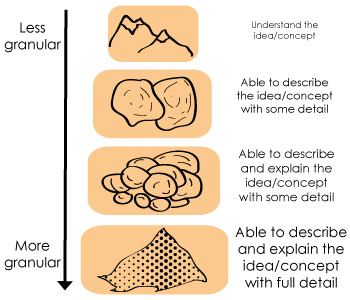Granularity
 It is common, when learning a second language, to have many questions about why the language functions as it does, why certain elements of culture exist, etc. Often higher level language learners, such as SL student teachers or SL teachers, will engage in discussions about these issues and similar topics. In order for these discussions to be useful, those involved must try to speak with as much clarity as possible—what we refer to as granularity. In the section that follows we will look at what the term granularity means, how teaching professionals can use and apply the term and its underlying meaning, and how it can be used in the SL classroom.
It is common, when learning a second language, to have many questions about why the language functions as it does, why certain elements of culture exist, etc. Often higher level language learners, such as SL student teachers or SL teachers, will engage in discussions about these issues and similar topics. In order for these discussions to be useful, those involved must try to speak with as much clarity as possible—what we refer to as granularity. In the section that follows we will look at what the term granularity means, how teaching professionals can use and apply the term and its underlying meaning, and how it can be used in the SL classroom.
What is granularity?
The term “granularity” means working for or towards clarity. At the most foundational level, granularity = grain + clarity. In order to fully understand what this word means and all that it encompasses, it is perhaps best to think about it in terms of the following visual metaphor:
 Picture granularity as the difference between a mountain, boulders, rocks and pebbles. It starts as the difference between being acquainted with a mountain, something you feel far removed from but have some slight knowledge about, and being acquainted with boulders, which are parts of the mountain and much smaller. After the boulders, we look at the rocks, which are smaller still, and move towards pebbles and then grains of sand.
Picture granularity as the difference between a mountain, boulders, rocks and pebbles. It starts as the difference between being acquainted with a mountain, something you feel far removed from but have some slight knowledge about, and being acquainted with boulders, which are parts of the mountain and much smaller. After the boulders, we look at the rocks, which are smaller still, and move towards pebbles and then grains of sand.
When we talk about being more “granular”, we are looking at getting as close to grains of sand as we can with our descriptions.
back to top
How can teachers apply the concept of granularity?
While this concept can be applied to and used with students at a more basic level, it is best suited to teachers and teacher candidates (i.e. those completing their studies in education). As mentioned above, the purpose of granularity is to become as clear as possible; for teachers, this means shifting your thinking and the way in which you express yourself so that you personally gain clarity about your ideas and are then able to express that clarity to those around you. To practice thinking and speaking with more granularity, ask yourself “How can I be more granular?” The important thing to remember is that by explaining or discussing something in as much detail as you possibly can, you not only make the concept at hand clearer and more understandable for those around you, but it also becomes clearer to you. In the classroom, granularity can be used, for example, when it comes to classroom routines and procedures. As the following link demonstrates, being as precise and clear as possible (i.e. being granular) with your routines and procedures will make for a more effective and successful learning environment: http://www.educationoasis.com/instruction/CM/routines.htm
back to top
How can I use granularity with my SL students?
Granularity is quite an “academic” term, and as such is better to explain and discuss with student-teachers and teachers. From a teacher’s perspective, many students may feel that they are still at the level of a mountain when it comes to being acquainted with the SL. This is especially common for students studying in a foreign language setting where they are not exposed to the language outside of the classroom. To help students move towards more clarity with their SL (i.e. move from being acquainted with a mountain to being acquainted with boulders or even rock) try introducing the concept to them without using the word “granularity”; explain to students that they are being challenged to use higher-level thinking such that they can express themselves with as much clarity as possible. Additionally, encourage students to ask you for more clarity (i.e. granularity) so they can use and understand the SL even better.









